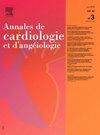Safety of exercise training for cardiac patients : results of a French multicenter COCARE study (COmplications in CArdiac REhabilitation)
IF 0.3
Q4 Medicine
引用次数: 0
Abstract
Background
Cardiac rehabilitation is widely recognized as beneficial for patients with coronary artery disease, post-cardiac surgery, and heart failure, although it is underutilized. However, the benefit-risk balance must be updated to reflect the evolving characteristics of treated populations.
Objective
To evaluate the safety of supervised exercise training in a large sample of French cardiac rehabilitation patients, and to assess the utility of the modified Risk of Activity Related Events (RARE) score in identifying low-risk individuals.
Methods
This multicenter observational study included 6,793 patients from 32 centers surveyed between 2023 and 2025. Each center collected data over four consecutive months, including patient characteristics and events that interrupted programs, required transfer to acute care, or resulted in rehabilitation cessation. The modified RARE score was applied to identify a low-risk subgroup. Events were considered activity-related if they occurred during or within one hour of a training session.
Results
A total of 964 events (14.2%) were reported, of which 154 (2.3%) were activity-related. Two cardiac arrests occurred—one fatal—representing 0.98 cardiac arrests and 0.49 deaths per 100,000 patient-hours of training. A modified RARE score < 4 defined a low-risk group with an area under the ROC curve of 0.67 and an excellent negative predictive value (0.99). However, specificity was limited (0.32), reflecting the low incidence of events even in high-risk patients.
Conclusion
The COCARE study confirms the low risk of supervised exercise in phase II cardiac rehabilitation. The modified RARE score may be useful in identifying patients who could safely benefit from alternative, less monitored formats such as telerehabilitation.
运动训练对心脏病患者的安全性:一项法国多中心COCARE研究结果(心脏康复并发症)
背景:心脏康复被广泛认为对冠状动脉疾病、心脏手术后和心力衰竭患者有益,尽管它尚未得到充分利用。然而,必须更新利益-风险平衡,以反映治疗人群不断变化的特征。目的评估法国心脏康复患者大样本中监督运动训练的安全性,并评估改进的活动相关事件风险(RARE)评分在识别低风险个体中的效用。该多中心观察性研究纳入了来自32个中心的6793例患者,调查时间为2023年至2025年。每个中心收集了连续四个月的数据,包括患者的特征和中断项目的事件,需要转到急性护理,或导致康复停止。采用改良的RARE评分来确定低风险亚组。如果事件发生在训练期间或一小时内,则被认为与活动有关。结果共报告964例(14.2%),其中运动相关154例(2.3%)。发生了两次心脏骤停,其中一次是致命的,这意味着每10万患者小时的训练中有0.98次心脏骤停和0.49次死亡。修改后的RARE评分<; 4定义为低风险组,ROC曲线下面积为0.67,极好的阴性预测值(0.99)。然而,特异性有限(0.32),反映了即使在高危患者中事件的发生率也很低。结论COCARE研究证实了监督运动在二期心脏康复中的低风险。修改后的RARE评分可能有助于确定哪些患者可以安全地受益于其他较少监测的形式,如远程康复。
本文章由计算机程序翻译,如有差异,请以英文原文为准。
求助全文
约1分钟内获得全文
求助全文
来源期刊
CiteScore
0.60
自引率
0.00%
发文量
68
审稿时长
6-12 weeks
期刊介绍:
Organe scientifique de référence fondé en 1951, les Annales de cardiologie et d''angéiologie abordent tous les domaines qui intéressent quotidiennement les cardiologues et les angéiologues praticiens : neurologie et radiologie vasculaires, hémostase, diabétologie, médecine interne, épidémiologie et prévention.
Les Annales de cardiologie et d''angéiologie sont indexées aux grandes bases de données et publient rapidement, et en conformité avec les normes internationales de publication scientifique, des articles en français sur la pathologie cardiaque.

 求助内容:
求助内容: 应助结果提醒方式:
应助结果提醒方式:


